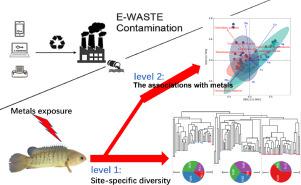Aquatic Toxicology ( IF 4.1 ) Pub Date : 2022-04-12 , DOI: 10.1016/j.aquatox.2022.106171 Wanglong Zhang 1 , Tengzhou Li 2 , Yufeng Li 2 , Yongchao Ma 3 , Heidi Qunhui Xie 4 , Xianghui Zou 5 , Jiameng Wu 2 , Yunping Li 6 , Renjun Wang 2 , Bin Zhao 4

|
Due to the production of large quantities of electronic waste (e-waste), unsafe dismantling has caused serious pollution as well as toxicological impacts on both wildlife and humans. As an important aspect of physiology and health, the wildlife's gut microbiota and its changes induced by pollution have been recruiting increasing concerns. To reveal the gut microbiota-related ecotoxicology induced by e-waste dismantling, this study resolves the gut microbiota profile of Anabas testudineus, a native highly adapted nonmodel fish under the in situ exposure, and reveals whether and how the microbiota was altered. The comparisons are made by collecting samples from different e-waste polluted sites in Guiyu (a town in South China) and a nearby reference (nonpolluted) site. The overall gut microbiota landscape of A. testudineus is similar to that of other reported fishes, with an average of ∼300 OTUs, and constituted by Firmicutes (34.51%), Fusobacteria (29.16%) as the major phyla. Obviously different liver metal burdens/fingerprints were observed between the e-waste and reference sites. Accordingly, although the alpha-diversity (ACE, Simpson, and Shannon) of the gut microbiota did not significantly vary, a detailed exploration of the microbiota constitution indicated significant differences at various taxonomic levels, including a series of significantly different species and biomarkers, and showing site-specific beta-diversity clustering patterns. Interestingly, a few bacteria with greater abundance in the fish gut of e-waste polluted sites were also reported to present in other contaminated environments, have a role in wastewater treatment, be capable to transform metal, etc. Redundancy analysis (RDA) and Pearson association analyses indicated significant associations between Mn and Cetobacterium somerae (Pearson r = 0.3612, p = 0.0008) and between Pb and Clostridium colicanis (Pearson r = 0.5151, p < 0.0001). In summary, pollution from e-waste dismantling may have a role in altering the fish gut microbiota, and this research provides insights for better understanding e-waste ecotoxicology and improving future conservation.









































 京公网安备 11010802027423号
京公网安备 11010802027423号